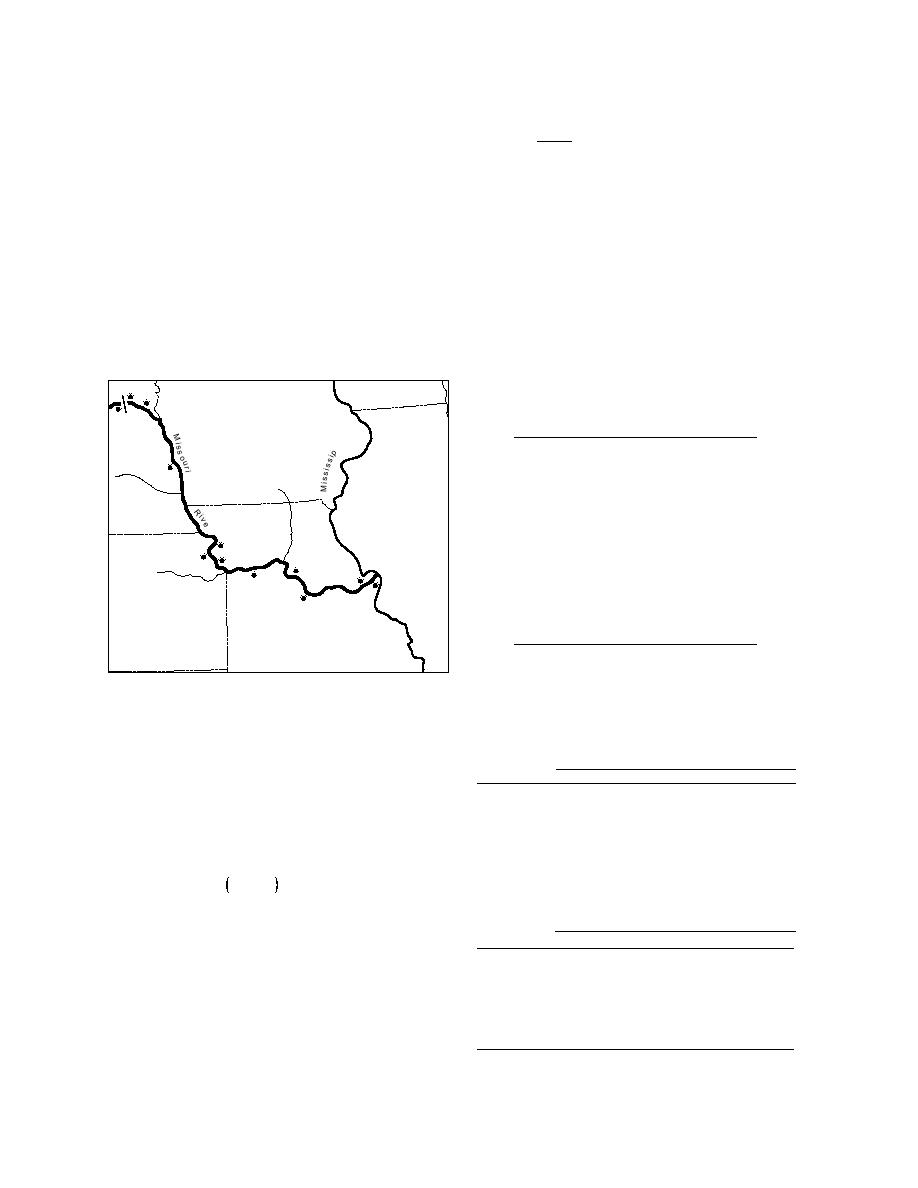
the most potential problems, since dips present in
was plotted on probability paper against its plot-
these reaches tend to travel downstream, and the
position or exceedance frequency (E) defined as
decreased discharge can exacerbate downstream ice
r 100
jams. Therefore, further study of discharge effects is
E=
(2)
N +1
based on reach 1 data.
where N = number of years in period of records
(40 years or less if there were missing
STATISTICAL ANALYSIS OF
data).
WEATHER DATA
r = rank of particular value of FDDn over
The daily average air temperatures for the win-
the period of record (r = 1 to N)
ter season months October to March were col-
lected from 13 weather stations along the Missouri
As an example, the particular plots for the month of
River from Sioux Falls, S.D., to St. Louis, Mo. (see
January at Yankton, S.D., are presented in Figure 8a.
Table 3 and Fig. 7). The data were collected by
Every single such plot (for all months at all stations)
water years for the period 19501989.
could be fitted by a straight line with a correlation
Table 3. Weather stations used in tem-
S.D. 3
WISCONSIN
4
perature analysis.
2
Station
River mile
P avins
G
IOWA
t. Dam
R.
pi
1.
Sioux Falls
--
2.
Gavins Point Dam
811
5
3.
Yankton
806
4.
Vermillion
773
5.
Nebraska City
562
NEBRASKA
ILLINOIS
r
6.
St. Joseph
448
6
7.
Atchison
422
8.
Kansas City, Mo.
366
7
8
10
9.
Lexington
317
12
9
10.
Booneville
197
13
11.
Jefferson City
144
11
12.
St. Charles
28
KANSAS
MISSOURI
13.
St. Louis
18
Table 4. Characteristics of normal distribution
function of freezing-degree-days at Yankton,
Figure 7. Location map of weather stations used in tem-
S.D.
perature analysis.
a. Mean FDD (C)
For each winter month at each station, the cu-
Duration (days)
mulative freezing-degree-days (FDD) over 1, 2, 3,
Month
1
2
3
5
10
5, and 10 consecutive days were calculated and
October
0.6
3.7
8.8
22.9
68.9
ranked in increasing order of magnitude over the
November
9.5
16.5
21.1
25.5
25.6
40-year record. The cumulative freezing-degree-
December
18.0
31.8
43.2
63.2
104.2
day in C is defined by
January
21.9
40.9
57.1
84.3
140.8
February
18.4
34.0
46.4
66.4
106.9
n
March
11.4
20.6
27.4
37.8
48.0
∑ To Ti
FDDn =
(1)
b. Standard deviation (C)
i= 1
Duration(days)
where n = number of consecutive days (1 to 10)
Month
1
2
3
5
10
To = freezing temperature of water (0C)
October
2.5
5.2
8.1
12.9
22.8
Ti = average air temperature on day i (in
November
5.1
9.8
14.3
22.1
36.4
C).
December
4.8
9.7
14.5
24.8
49.0
January
3.9
7.9
11.8
21.7
43.5
For each month, each station, and accumulation
February
4.5
9.2
13.5
23.1
46.6
March
5.5
10.5
14.8
24.3
44.9
period (1, 2, 3, 5, and 10 days), the calculated FDDn
8



 Previous Page
Previous Page
